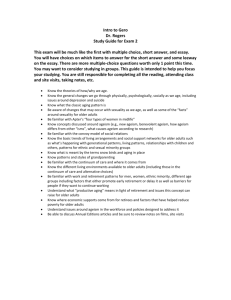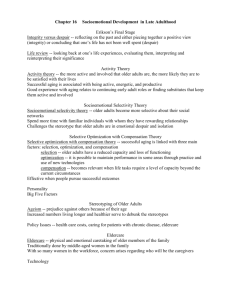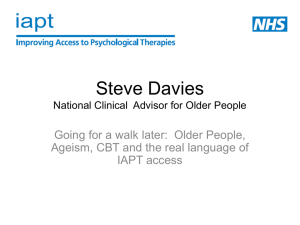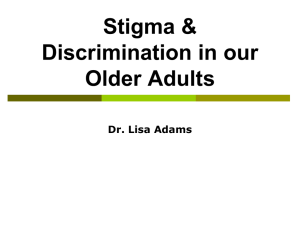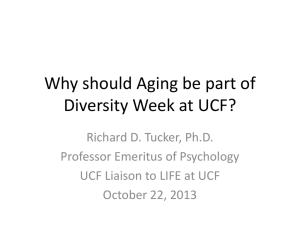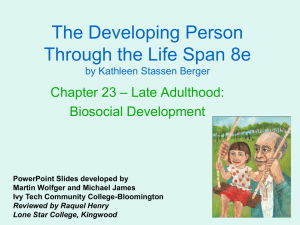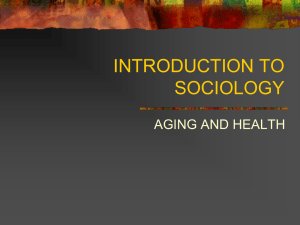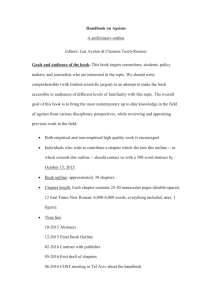How Media Perpetuates Ageism
advertisement
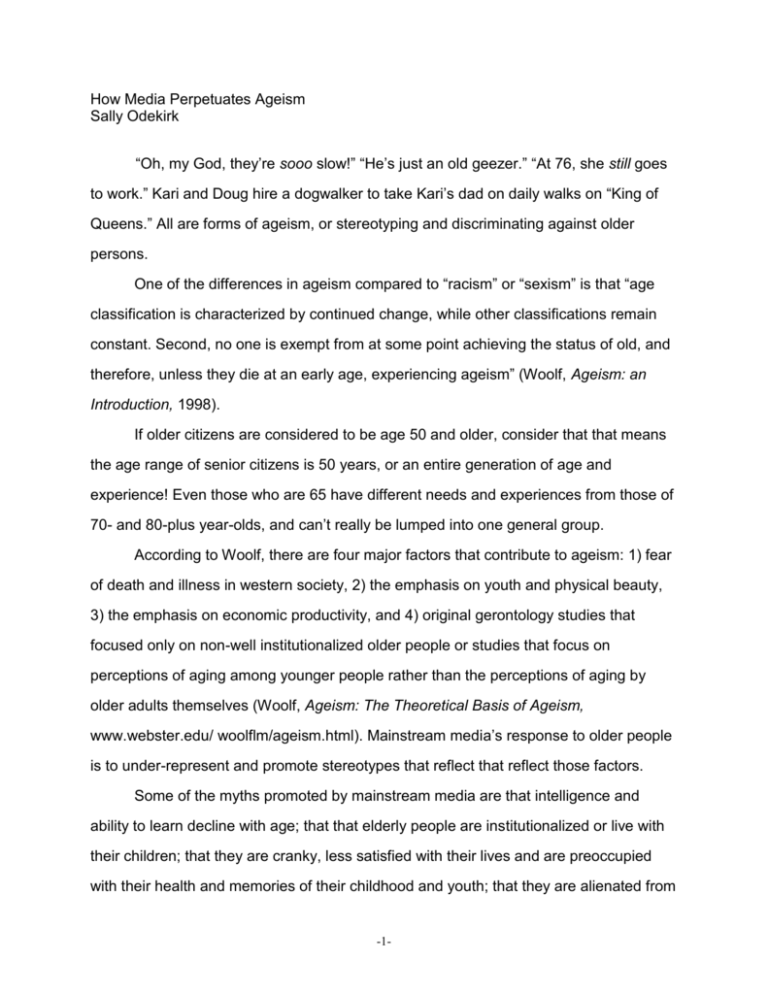
How Media Perpetuates Ageism Sally Odekirk “Oh, my God, they’re sooo slow!” “He’s just an old geezer.” “At 76, she still goes to work.” Kari and Doug hire a dogwalker to take Kari’s dad on daily walks on “King of Queens.” All are forms of ageism, or stereotyping and discriminating against older persons. One of the differences in ageism compared to “racism” or “sexism” is that “age classification is characterized by continued change, while other classifications remain constant. Second, no one is exempt from at some point achieving the status of old, and therefore, unless they die at an early age, experiencing ageism” (Woolf, Ageism: an Introduction, 1998). If older citizens are considered to be age 50 and older, consider that that means the age range of senior citizens is 50 years, or an entire generation of age and experience! Even those who are 65 have different needs and experiences from those of 70- and 80-plus year-olds, and can’t really be lumped into one general group. According to Woolf, there are four major factors that contribute to ageism: 1) fear of death and illness in western society, 2) the emphasis on youth and physical beauty, 3) the emphasis on economic productivity, and 4) original gerontology studies that focused only on non-well institutionalized older people or studies that focus on perceptions of aging among younger people rather than the perceptions of aging by older adults themselves (Woolf, Ageism: The Theoretical Basis of Ageism, www.webster.edu/ woolflm/ageism.html). Mainstream media’s response to older people is to under-represent and promote stereotypes that reflect that reflect those factors. Some of the myths promoted by mainstream media are that intelligence and ability to learn decline with age; that that elderly people are institutionalized or live with their children; that they are cranky, less satisfied with their lives and are preoccupied with their health and memories of their childhood and youth; that they are alienated from -1- their families and society in general; and that senior citizens are asexual beings and undesirable. Studies conducted do not reflect these stereotypes. For example, the National Council on Aging says that over 14% of those age 65 and older are in the labor force, and a growing number use the Internet or take community and college courses for social and intellectual growth. They also says that 81% of homeowners 62 and older own their own homes. “Of people over the age of 65, 4.5% lived in nursing homes in 2000. While this number is relatively small, the percentage rises steeply with age (1.1% for persons 65–74; 4.7% for persons 75–84; 18.2% for persons 85 and older)” (www.ncoa.org/press room/fact sheet). In a recent discussion with my 80-year-old father and a 70-year-old family friend, both men said that they are enjoying their lives as senior citizens because they have more time to explore areas of interest that they couldn’t when they were younger, and a feeling that they don’t have to live up to other people’s expectations. In a survey conducted in 1997, 36% of participants in their 60s rated “right now” as the best time in their lives. “When questioned about the least satisfying life period, interviewees who were young-old and old-old selected childhood and adolescence. Contrary to the myth of the youth-obsessed older adult, the era of childhood does not become more cheriched with age” (Denmark, Myths of Aging, source). Another problem of agism is the under-representation in the media. A study conducted in 2002 found that while the elderly population is estimated to be 12% of the population, only 3% of characters portrayed on primetime network television are portrayed as elderly, and women and minorities are represented even less frequently. According to the survey, “the comparison of chronological age and social age isolates gender-related differences for characters judged to be 50 or older. . . . Only one in ten of the male characters between 50 and 64 is categorized as elderly, while more than a -2- quarter of the female characters are classified as elderly (Signorielli, Aging on Television, p. 290). Advertisers understand the importance of mature adults and their spending power, and cater to those who are well-off older folks using models several years young than the target audience. In a survey of advertising in mainstream magazines in 2001, models over 50 were rarely in the magazines. The summary: “If we were to draw a picture of American life exclusively from [the 31 magazines surveyed] we would have to conclude that the consuming population consists primarily of people 18–49 years old” (Vesperi, Aging in the Media, 7). She also says that by showing only the healthy, wealthy portion of the senior population, unrealistic expectations and competition between the generations can result. She says: “While touted as a market opportunity in many quarters, the baby boom has also emerged as a threatening demographic group in discussions of aging. Beyond the obvious issues . . . new issues are beginning to register on the social agenda. Discussions of housing, employment, and consumer spending among aging boomers often emphasize the depletion of resources for younger groups rather than the potential of healthy, well-educated retirees with discretionary incomes to make significant civic contributions” (Vesperi, Forty-Nine Plus: Shifting Images of Aging in the Media, p. 4). Not long ago I attended a discussion on the needs of migrant workers that also apply to the needs of the elderly. Someone commented that what they need to know is that they can make legitimate contributions to society, and they should be allowed to do so. When we marginalize older adults through stereotypes and under-representation we waste a valuable economic and social resource. -3- Sources: Denmark, Florence L., “Myths of Aging,” Eye on Psi Chi, The National Honor Society in Psychology, Vol. 7:1, Fall 2002. Online: http://www.psichi.org/pubs/articles/article_38.asp National Council on Aging, The. “Older Americans,” available online at www.ncoa.org/press room/fact sheet. Signorielli, Nancy. “Aging on Television: Messages Relating to Gender, Race, and Occupation in Prime Time,” Journal of Broadcasting and Electronic Media, June 2004, p. 290. Vesperi, Maria, Forty-Nine Plus: Shifting Images of Aging in the Media, (Harvard: 2003), p. 4. Online: http://www.cel.sfsu.edu/olli/resources/Vesperi.pdf Woolf, Linda M. 1998. Ageism: an Introduction; Ageism: The Theoretical Basis of Ageism, available online at: www.webster.edu/˜woolflm/ageism.html. -4- Quiz on Ageism Below are a series of statements that are some of the common beliefs about aging in the United States. Taken from the Aging Quiz by Linda M. Woolf, Ph.D., Webster University. Can be found online at: http:/www.webster.edu/˜˜woolflm/gero.html. 1. The majority of older adults will become senile (defective memory, disoriented, demented) during old age. True or False 2. Most older adults have no desire or capacity for sexual relations. True or False 3. Chronological age is the most important determinant of age. True or False 4. More older adults have difficulty adapting to change; they are set in their ways. True or False 5. Physical handicaps are the primary factors limiting the activities of older adults. True or False 6. Physical change tends to decline in old age. True or False 7. Intelligence declines with old age. True or False 8. The majority of older adults say that they are happy most of the time. True or False 9. About 80% of older people say they are healthy enough to carry out their normal daily activities independently. True or False 10. Most older adults are rejected by their children. True or False 11. In general, most older adults tend to be pretty much alike. True or False 12. The majority of older adults say that they are lonely. True or False 13. Over 12% of the population of the United States is over the age of 65. True or False 14. Most older adults tend to be preoccupied with death. True or False 15. Most older adults wish they were young again. True or False 16. Gender has no impact on ageism. True or False -5- 17. Ageism is not a universal, cross-cultural phenomenon. True or False Ageism Quiz Answers 1. The majority of older adults will become senile (defective memory, disoriented, demented) during old age. True or False 2. Most older adults have no desire or capacity for sexual relations. True or False 3. Chronological age is the most important determinant of age. True or False 4. More older adults have difficulty adapting to change; they are set in their ways. True or False 5. Physical handicaps are the primary factors limiting the activities of older adults. True or False 6. Physical strength tends to decline in old age. True or False 7. Intelligence declines with old age. True or False 8. The majority of older adults say that they are happy most of the time. True or False 9. About 80% of older people say they are healthy enough to carry out their normal daily activities independently. True or False 10. Most older adults are rejected by their children. True or False 11. In general, most older adults tend to be pretty much alike. True or False 12. The majority of older adults say that they are lonely. True or False 13. Over 12% of the population of the United States is over the age of 65. True or False 14. Most older adults tend to be preoccupied with death. True or False 15. Most older adults wish they were young again. True or False -6- 16. Gender has no impact on ageism. True or False 17. Ageism is not a universal, cross-cultural phenomenon. True or False -7- Presentation: “Turn down that stereotype” Ageism caused by 4 factors: 1. Fear of death and aging in western society 2. Emphasis on youth and physical beauty 3. Emphasis on economic productivity 4. Original gerontology studies that focused on non-well institutionalized older adults and on perceptions about age from younger population. (Talking at but not to the older adults) Examples from the media: 1. A study in 2002 found that out of a population of approximately 12% of older adults, only 3% were represented on primetime network television, with women and minorities the least represented. What’s the problem of being under-represented? 2. Elderly characters are portrayed mainly as either comical, eccentric and crabby. (Examples: parents of Seinfeld, King of Queens, and Everybody Loves Raymong) or wise, active, powerful and affluent (Examples: Matlock, Golden Girls, Murder She Wrote, Touched by an Angel) 3. Advertisers cater to those who are well-off older folks showing healthy, wealthy older adults, but even then, older models are only shown sparingly. “If we were to draw a picture of American life exclusively from 31 magazines surveyed, we would have to conclude that the consuming population consists primarily of people 18–49 years old.” What’ s the problem with stereotypes? Quiz on aging and discussion -8-
